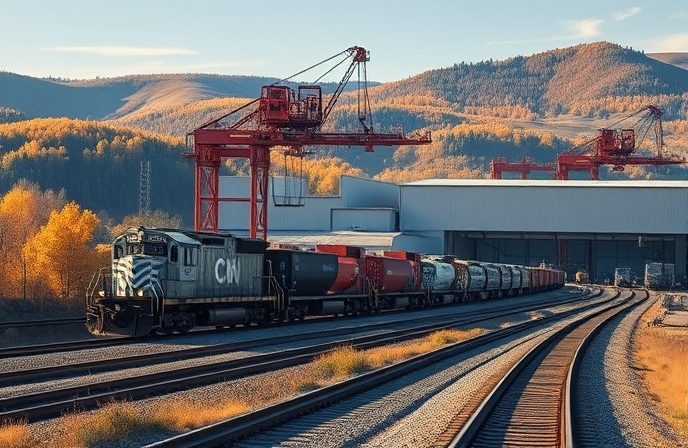Melbourne Intermodal Terminal: Australia’s Rail-Based Freight Hub
Victoria’s largest intermodal terminal, the $400M Melbourne Intermodal Terminal (MIT), opens October, boosting rail freight efficiency and national supply chains. Enhanced rail capacity and electric gantry cranes are key features.

Introduction
The Intermodal Terminal Company (ITC) is set to significantly enhance freight and logistics efficiency and cost-effectiveness within Victorian and national supply chains with the development of its $400 million Melbourne Intermodal Terminal (MIT). This project, located in the industrial north of Melbourne, is backed by Aware Super and represents Victoria’s largest facility of its type, encompassing over 30 hectares of concrete terminal hardstands.
MIT Facility and Capacity
The 45-hectare MIT is designed to provide substantial rail capacity for Victoria starting in October of this year. Initially, the terminal will be equipped with seven rail-mounted gantry cranes supplied by Konecranes, with four in the Inner Terminal and three in the Outer Terminal. These cranes will enable the MIT to process one million shipping containers (TEUs) annually. The terminal’s infrastructure and equipment are designed to accommodate future growth, allowing for a total of 12 gantry cranes in service, processing an increasing volume of import/export (IMEX: port shuttle) and interstate TEU movements. The facility is engineered to handle Victoria’s interstate rail freight demand, including anticipated volumes from the Inland Rail project, through to the late 2050s.
Gantry Crane Specifications and Capabilities
Each of the 25-meter-high, 350-tonne gantry cranes at the MIT is capable of lifting or loading up to 46 shipping containers (TEUs) per hour. Notably, these gantry cranes are fully electric and incorporate a kinetic process that allows them to regenerate electricity back into the grid during container lifting and loading operations. The MIT is described as Australia’s most state-of-the-art intermodal terminal, featuring an open access regime, customs-bonded storage, an empty container park, and on-site facilities for washing, fumigating, and repairing shipping containers.
Strategic Location and Connectivity
The MIT’s strategic location is highlighted by its proximity to key freight generators and transport links. It is situated just 20 kilometers by rail from the Port of Melbourne, Australia’s largest maritime trade hub, and is directly adjacent to the Hume Freeway. The terminal’s location is further enhanced by its surrounding environment, which includes approximately 20 percent of Victoria’s freight volumes and over three million square meters of existing warehousing within a seven-kilometer radius. The forthcoming completion of the North East Link is expected to provide seamless access to the MIT for an additional 25 percent of freight volumes from the South East region.
Economic and Operational Benefits
ITC CEO Mishkel Maharaj stated that the MIT will increase the utilisation of the existing Australian Rail Track Corporation (ARTC) interstate network and the future Melbourne-Brisbane Inland Rail by enabling rail freight services to operate closer to Melbourne’s key industrial and logistics precincts. This proximity is projected to reduce last-mile truck movements, thereby boosting productivity by decreasing truck travel time, reducing supply chain costs, alleviating traffic congestion, and minimizing road damage, accidents, and vehicle emissions. The MIT is a central component of the larger Melbourne Intermodal & Industrial Exchange (MIIX) development by Aware Real Estate and Barings, representing a combined $1.6 billion investment, the largest private investment in Victoria’s freight and logistics sector in a generation. The MIT will offer precinct tenants co-located warehousing and logistical services.
Employment and Alignment with Government Plans
Current construction activities at the MIT are employing up to 200 skilled Victorian workers weekly. Upon becoming operational, the intermodal terminal is expected to employ approximately 60 essential freight workers, including train crews, truck drivers, forklift operators, freight controllers and dispatchers, and warehouse technicians. The MIT and MIIX developments align with federal and state initiatives such as the National Rail Action Plan, the future Melbourne-Brisbane Inland Rail, the 2023 Critical Infrastructure Resilience Strategy, and the Victorian Freight Plan 2025-30, which lists support for the delivery of the intermodal terminal at Somerton as a priority action for the Department of Transport and Planning.
Company Summary
Intermodal Terminal Company (ITC): Developer of the Melbourne Intermodal Terminal (MIT).
Aware Super: Investor backing the Melbourne Intermodal Terminal (MIT).
Konecranes: Supplier of the rail-mounted gantry cranes for the MIT.
Australian Rail Track Corporation (ARTC): Operator of the existing interstate rail network.
Aware Real Estate: Developer of the Melbourne Intermodal & Industrial Exchange (MIIX).
Barings: Developer of the Melbourne Intermodal & Industrial Exchange (MIIX).
Technology
Rail Mounted Gantry Cranes: Heavy machinery used for loading and unloading shipping containers from trains. The cranes at MIT are fully electric and capable of regenerating electricity.
Intermodal Terminal: A facility where freight is transferred between different modes of transportation, such as rail and road.
Import/Export (IMEX: port shuttle): Refers to the movement of shipping containers for import and export purposes, including shuttle services to and from ports.
TEU (Twenty-foot Equivalent Unit): A standard unit of measurement for shipping containers.
Inland Rail: A major infrastructure project to enhance freight rail connectivity between Melbourne and Brisbane.
Kinetic Process: A physical process involving motion and energy. In this context, it refers to the energy generated during the movement of the gantry cranes.
Open Access Regime: A system allowing multiple operators to use transport infrastructure.
Customs-Bonded Storage: A facility where imported goods can be stored without payment of duty or tax until they are released into the domestic market.
Empty Container Park: An area designated for the storage of empty shipping containers.



